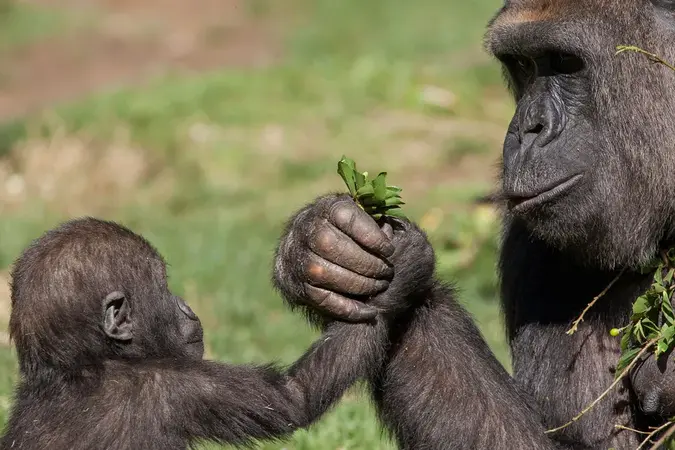In the dense rainforests of Africa, a remarkable phenomenon has intrigued biologists and researchers for decades: gorillas, our closest relatives in the animal kingdom, appear to self-medicate using natural plants found in their environment. This behavior, known as zoopharmacognosy (from the Greek “zoo” for animal and “pharmacon” for drug), refers to the process where animals select and use plants, soils, or insects to treat illnesses, infections, or parasites. While self-medication in animals has been observed across various species, gorillas’ behavior is particularly compelling due to their sophisticated dietary choices, which may hold clues to novel drugs for human medicine.
This article explores the fascinating world of self-medicating gorillas, how their behavior could lead to new medical discoveries, and what this means for the future of drug development.
The Science Behind Zoopharmacognosy: Self-Medication in Animals
Zoopharmacognosy is not just restricted to gorillas; it has been observed in a variety of species including birds, insects, and even domestic pets. However, primates, due to their genetic and behavioral closeness to humans, have been the focal point of numerous studies.
In the wild, gorillas have been seen to consume particular plants that they don’t normally eat as part of their regular diet. These plants, which are often bitter and difficult to digest, are believed to have medicinal properties. Such behavior suggests that gorillas are aware of the health benefits of these plants and consume them only when necessary, typically when they are suffering from infections, parasites, or digestive problems.
For example, scientists have documented gorillas in Rwanda consuming the leaves of Vernonia amygdalina, a plant known for its bitter taste. Local people have long used the plant for its medicinal properties, particularly for treating parasites and infections. Gorillas seem to consume this plant only when they show signs of illness, suggesting an instinctual knowledge of the plant’s healing properties.
Observing Gorillas’ Natural Pharmacy: How It Works
Gorillas, like many other primates, exhibit highly selective feeding habits. They tend to eat nutrient-rich foods like fruits, leaves, and shoots, but on occasion, they deviate from their regular diet to consume plants with known medicinal qualities. When gorillas are observed consuming these atypical plants, it’s usually in small quantities, and often in a ritualistic manner that points toward deliberate self-medication.
There are several well-documented examples of self-medicating behavior in gorillas:
- Vernonia amygdalina: As mentioned earlier, this plant is commonly ingested by gorillas suffering from parasitic infections. Its bitter compounds are believed to have anti-parasitic properties, similar to how humans use herbal medicines.
- Aspilia mossambicensis: Another plant ingested by primates for its ability to expel parasites. Gorillas may chew or swallow leaves from this plant to coat their stomachs and intestines, helping to dislodge parasites or toxins.
- Bitter piths and barks: Gorillas have also been observed consuming parts of trees and plants that contain tannins, which have anti-inflammatory and astringent properties.
These plants are often avoided by healthy gorillas, which strongly suggests that their consumption is linked to specific health issues, not a regular dietary choice. When researchers follow gorillas in the wild, they notice that consumption of medicinal plants is often followed by improvement in symptoms, such as increased activity and reduced signs of illness.
Learning from Gorillas: Potential for Human Medicine
The idea that animals can teach us about medicine is not new. Indigenous populations worldwide have long observed animal behavior to discover medicinal plants and treatments. Now, modern science is catching up. The careful study of gorillas’ self-medicating behaviors could provide important clues for new drugs, particularly in the areas of anti-parasitic and anti-bacterial treatments, pain management, and even cancer therapies.
Here are some promising avenues for drug discovery:
1. Anti-parasitic Treatments
One of the most studied aspects of zoopharmacognosy is the use of plants by gorillas and other primates to treat parasitic infections. Given the rising resistance to conventional anti-parasitic drugs, discovering new plant-based treatments could be crucial in the fight against diseases like malaria, tapeworms, and roundworms. The bitter compounds in plants like Vernonia amygdalina have been found to have anti-malarial properties, making them potential candidates for new, more effective anti-parasitic drugs.
2. Anti-inflammatory and Pain-Relief Properties
Many of the plants consumed by gorillas contain compounds that can act as natural anti-inflammatories. These plants might offer alternatives to non-steroidal anti-inflammatory drugs (NSAIDs) like ibuprofen, which, although effective, can cause stomach ulcers and other side effects when used long-term. Discovering natural compounds that could reduce inflammation without harmful side effects would be a major advancement in medicine.
3. Cancer-Fighting Agents
Some of the bitter compounds in plants eaten by gorillas have been studied for their potential to fight cancer. Many plant-based cancer therapies used today, like taxol from the yew tree, were initially discovered through observation of natural ecosystems. Investigating the chemical properties of plants consumed by gorillas could lead to the discovery of new chemotherapy drugs or treatments that improve immune system responses to cancer.
4. Antibiotics and Antiviral Compounds
With the global rise in antibiotic-resistant bacteria, the search for new antibiotics has never been more urgent. Gorillas, through their consumption of specific plants, may already be employing natural antibiotics. Some plant species consumed by gorillas have been found to contain compounds that inhibit bacterial growth, a promising area of research for developing new antibiotics that could combat resistant strains of bacteria like MRSA (Methicillin-resistant Staphylococcus aureus).
Challenges in Studying Zoopharmacognosy
While the potential benefits of studying gorillas’ self-medication habits are significant, there are also challenges that researchers face. Gorillas live in dense, difficult-to-navigate rainforests, which can make long-term observation challenging. Additionally, the subtlety of their behaviors, like ingesting small quantities of specific plants, can easily be overlooked without careful and sustained study.
Another challenge lies in isolating the active compounds in the plants consumed by gorillas. Even if a plant is known to have medicinal properties, identifying which specific chemicals are responsible for the therapeutic effects is a complex and time-consuming process.
Finally, translating the findings from gorillas to humans requires extensive clinical testing. What works for a gorilla may not always work for a human, given the differences in physiology and metabolism.
Conservation and Medical Research: A Symbiotic Relationship
The study of gorillas’ self-medicating behaviors highlights the importance of conservation efforts. The destruction of habitats due to deforestation, agriculture, and human encroachment not only threatens gorilla populations but also jeopardizes the natural pharmacies that they rely on. Protecting these habitats is crucial for both gorillas and humans, as it preserves the biodiversity that could lead to the discovery of new medicines.
Gorilla conservation and medical research are therefore deeply interconnected. By protecting gorillas and their ecosystems, we safeguard the possibility of future medical breakthroughs that could benefit human health.
Conclusion: Nature’s Prescription for Health
The self-medicating behaviors of gorillas offer a unique insight into the untapped potential of natural medicines. By observing and studying the dietary choices of these primates, researchers are beginning to uncover valuable clues about plant-based treatments that could lead to new drugs for humans. From anti-parasitic compounds to anti-inflammatory agents, gorillas may hold the key to unlocking the next generation of medicines.
The importance of studying zoopharmacognosy goes beyond just understanding animal behavior; it represents a bridge between conservation and medical innovation. As we continue to explore the world of natural remedies, the secrets held by self-medicating gorillas might offer solutions to some of our most pressing health challenges. By protecting these incredible animals and their habitats, we not only preserve their place in the world but also secure the potential for lifesaving medical discoveries.





It seems like a good , positive news , waiting for its real trial , on real human , rather than on animals , it may give people a hope of new cure.
Thanks for your feedback